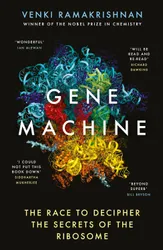This book was written by Venki Ramakrishnan, who shared the 2009 Nobel Prize in Chemistry for his role in discovering the structure of the ribosome.
Instead of being about the ribosome itself, this book is about the author’s career and his efforts in collaboration and competition with other scientists to determine the structure of the ribosome and how it works. Ramakrishnan doesn’t particularly try to explain all the science for a lay audience. I didn’t know anything about the ribosome before I read this book, and I didn’t actually learn all that much about what ribosomes are or what they do from reading it. Just enough is conveyed to make sense of the story: they seem to be components within cells that manufacture proteins, having received instructions on what proteins to make from RNA, which has ultimately been transcribed from the cell’s DNA. Ribosomes are also significant in understanding how antibiotics work, because these seem to affect the ribosome’s ability to manufacture proteins.
Ramakrishnan’s team used crystallography to figure out the structure of the Ribosome. One thing that comes across in the book is how painstaking the process of doing crystallography is. At one point, the team makes a mistake that costs them 2 years of effort, and small insights and improvements make a big difference to their success. I particularly enjoyed the descriptions of the LMB (Laboratory of Molecular Biology) in Cambridge, where the author spends some time and later returns for the most important work of his career. Here, Ramakrishnan discusses what it takes to create an atmosphere in which good science can be done, and how the LMB achieves this.
At one point, the author reflects on the nature of prizes in science, and the effect they have on scientists. As in The Code Breaker, as the possibility of winning the prize draws nearer, the competition between teams starts to get less friendly. Ramakrishnan also reflects on the effect of the prize on his own career, and whether it’s possible to continue to produce good science once you are a Nobel laureate. He also reflects on the fact that the awarding of prizes is fairly arbitrary. Lots of people were involved who weren’t recognised by the prize committee (only 3 people can share a Nobel). And which teams succeed often comes down to luck. The author is honest about his self-doubt at whether he could compete with the other teams, and seems genuinely surprised at winning the Nobel prize himself (although it would of course seem arrogant to expect to win it!)
It’s interesting to compare this book to The Code Breaker, another book about Nobel Prize-winning scientists working in molecular biology. Gene Machine is written by the scientist himself, and as result it feels a bit less journalistic than The Code Breaker. As Gene Machine was written by an active participant in the story, we may not be getting an objective view; Jennifer Doudna herself hints at this in her introduction. Walter Isaacson (the author of The Code Breaker) was more willing to highlight who he felt were the key characters, and give us more biographical and character information about them. Ramakrishnan isn’t really able to do the same, perhaps for fear of upsetting his former colleagues and rivals. Nevertheless, there are still some interesting characters in this book. I enjoyed the appearances of Ada Yonath, who seems to have the habit of delivering overly long lectures at scientific conferences and overrunning her slot.
Naturally for such a collaborative process, there are a lot of names of other scientists in this book and it can occasionally be a little hard to follow. Despite this, it held my interest throughout and the author puts a lot of his personality and feelings into the book to keep it engaging. As the story of someone who actually experienced the events involved in winning a Nobel prize, this gives a great account of what it’s like to do this kind of science.
